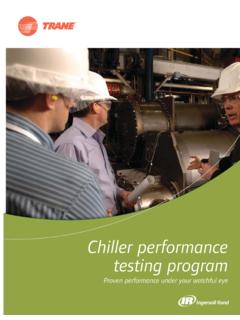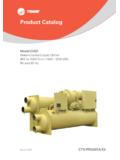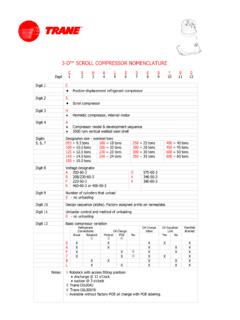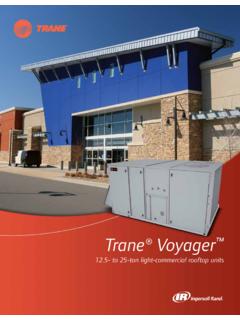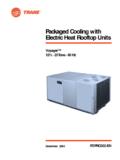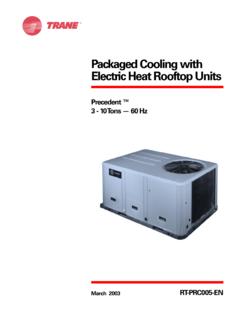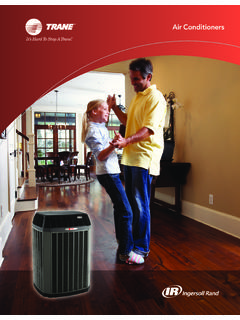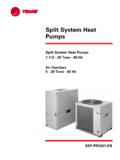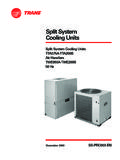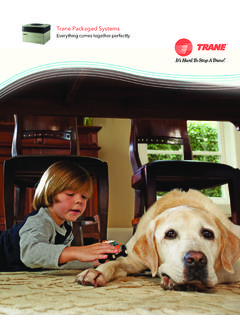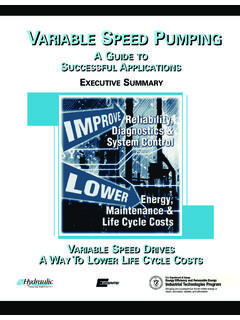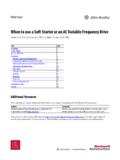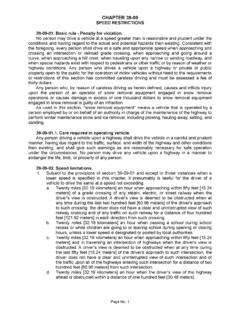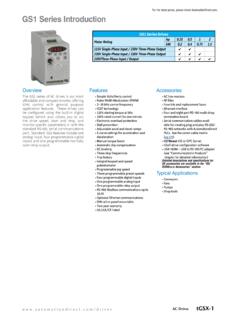Transcription of providing insights for today’s hvac system designer ...
1 providing insights for today 's hvac system designer Engineers Newsletter volume 43 2. Chilled-Water Systems Design Issues Learning from past mistakes designed as variable primary flow (VPF). [ kPa]. Even if the differential pressure As with anything in life, you can learn The bypass line (sized the same as the sensor is of high quality, it will be difficult to HVAC design the hard way, from supply manifold) and valve that allow select one that has the required precision to painful and costly mistakes, or the minimum chiller flow rate are located in accurately measure such a small difference easy way, from veteran engineers who can help you avoid those mistakes. the mechanical room, as are the air between design flow and minimum flow The purpose of this EN is to help new handlers.
2 A differential pressure sensor pressure drops. engineers with the latter. across the evaporator is used to determine flow rate and to control the Solution 1: Select the proper flow bypass valve.(Figure 1). sensing technology. Flow meters are generally more expensive, require more Background See any red flags? Let's take a look at the calibration, and must be installed per the problems that occurred on the job and manufacturer's requirements with a specific The following three cases are how to avoid making the same mistakes. amount of straight piping up- and down- composite scenarios of various chilled- stream. Despite these limitations, they're water system design issues we have Issue 1: Flow sensing device is not better suited to monitor flow for this witnessed over the years.
3 In each accurate enough at the minimum flow system . scenario, the design issues are rate. As mentioned, the design highlighted and followed by possible evaporator pressure drop is 5 ft of head Issue 2: Loop volume does not meet the solutions. [15 kPa]. At the minimum flow rate of chiller unit control requirement. Chiller gpm per ton [ L/s per kWr], the unit controls often require a certain loop By sharing the hard-earned HVAC pressure drop will be about 3 ft of head design wisdom that comes from trial volume to maintain good chilled-water and error, we hope to shorten the learning curve for new engineers. Figure 1. Case 1: New variable primary flow (VPF). DP 200-ton helical rotary chillers: minimum flow rate: 56 F ( C) 40 F ( C).
4 Case 1: New variable gpm/ton design pressure drop: Primary Flow 5 ft of head variable -speed A new system has been designed drive (VSD). using an increased system chilled- water temperature difference as recommended in the ASHRAE. GreenGuide1 and by Taylor2. The 6 in pipe chillers are selected at low design VSD. evaporator pressure drops (5 ft of head [15 kPa]) per chiller to minimize pump modulating AHUs in same power and energy. To reduce installed control valve equipment cost and operating costs, the system is for minimum room chiller flow 2014 trane , a business of Ingersoll Rand. All rights reserved. 1. temperature control and ensure that Many designers will use 4 in [10 cm] line The series chiller layout has two compressors are not cycled for this flow rate.
5 Then select a valve to significant benefits: unnecessarily. The loop volume give proper bypass control. While not includes the fluid in the evaporator required, some consulting engineers The upstream chiller operates at an bundle, pipes, and coils. In many close- specify a pressure independent valve for elevated temperature and increased coupled systems for example where bypass. efficiency. Very often this the air handlers and chillers are in the compensates for any increase in same equipment room the loop pump energy. Issue 4: Flow can't be significantly volume will not be adequate. The reduced. Chiller design flow rate is When chillers are piped in parallel in required loop volume varies by chiller gpm per ton [ L/s per kWr] and the a VPF system , there is a significant manufacturer, chiller type, and unit minimum is gpm per ton [ L/s flow rate change in the operating control capabilities.]
6 Check with the per kWr]. This means the flow rate can chiller when the second chiller is manufacturer for each chiller specified. only be reduced 20 percent before added. When the chillers are piped in In this case, the required loop time reaching minimum. That's not much for series, there is no flow rate transition was two minutes. So the system water a system that is supposed to be variable when the second chiller is enabled. volume required is the loop time primary flow. This can greatly simplify system multiplied by the water flow: control. 2 min. x 300 gpm = 600 gal Solution 4: Put the chillers in series! It may be beneficial to pipe the chillers in [2 min. x 60 sec. per min. x L/s = With chillers in series (Figure 2), the series if the system 2270 liters] design flow rate per chiller is about is designed for variable primary flow, gpm per ton [ L/s per kWr], Solution 2: Increase the loop volume allowing significant turndown.
7 Design has a chilled-water design to the required level. If the loop evaporator pressure drop increases temperature difference of 14 F. volume is close to that required, since water must flow through both [ C] or larger, increasing the piping manifolds may be evaporator bundles. This increases has two chillers, and adequate. Otherwise add a buffer tank, design pump power. However, in many preferably on the return side of the systems the flow rate is less than design is not likely to require a future system , and on the chiller side of the flow much of the year, so the resulting expansion. bypass line. Ensure the system volume pump energy increase may be small. If the system T is 10 F [ C], consider with the tank meets the required loop To allow for servicing, engineers often increasing it to 14 F [ C] or larger.
8 Volume. To attain smoother system control, consider making the tank a design manual bypass lines into the little larger than the absolute minimum system . requirement. The additional cost and space will likely be small. Issue 3: Oversized bypass line and Figure 2. New variable primary flow (VPF) series chillers valve do not provide adequate 56 F ( C) F ( C) 40 F ( C). control. The bypass line is the same size as the pipe manifold. Given this fact, if a large valve is installed in this Solution: line, control at the minimum flow rate may be a challenge, since initially install flow meter opening the valve a little allows increase loop volume by VSD adding a buffer tank significant flow to be bypassed.
9 Buffer manual bypass for servicing flow size the bypass line for the tank meter largest minimum flow rate Solution 3: Size the bypass line and valve properly. In a variable primary flow system , size the bypass line for the largest minimum flow rate. In this case: 200 tons x gpm per ton = 240 gpm [15 L/s]. 2 trane Engineers Newsletter volume 43 2 providing insights for today 's HVAC system designer Case 2: Conversion from Figure 3. Case 2: After value-engineered conversion to VPF. Primary Secondary to variable Primary Flow 54 F ( C). DP. 44 F ( C). VPF conversion plan: additional 30-tons of heat The system includes two 500-ton chillers recovery in a primary-secondary configuration. The Value engineering: owner wants to convert the system to pumps variable primary flow (VPF) and add a - use secondary pumps, small (30-ton) heat recovery chiller.
10 Don't move them This job is "value engineered" to: - remove primary pumps $100 DP sensor rather than use the existing secondary pumps magnetic flow meter (which can handle the flow and VSD VSD. pressure drop requirements), control switch out the high quality differential valve pressure sensor, which costs $1500, to a $100 sensor, and connect the heat recovery chiller in Add a matched pair of temperature and repeatability required to operate a parallel with the existing chillers sensors to monitor the system return- variable primary flow system . (Figure 3). water temperature and the chiller Unfortunately this seems to occur often. return-water temperature. We suggest you resist the temptation to Issue 1: The pumps are positioned reduce costs when value will be lost.
